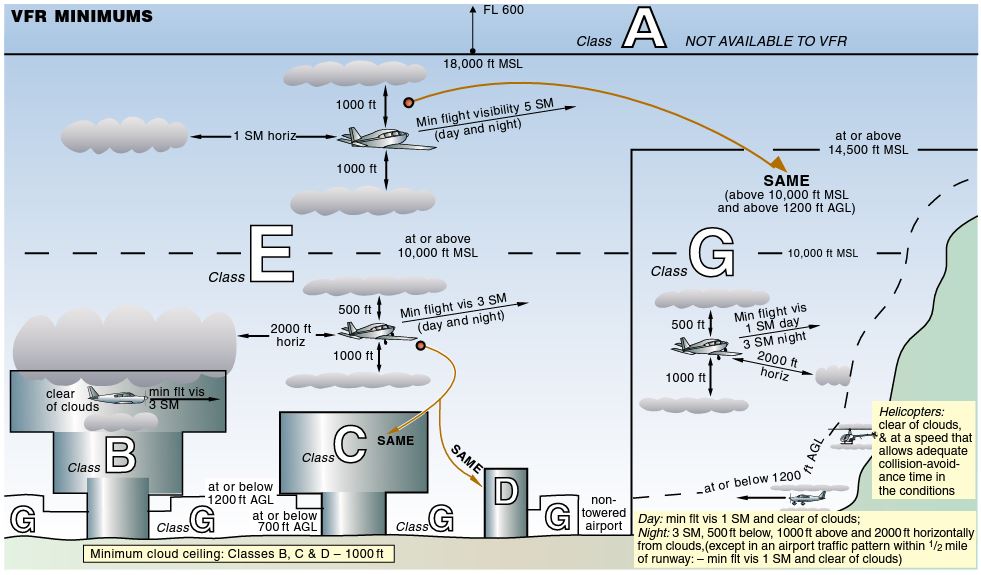
Why do two totally different concepts have virtually the same name?
I have no idea. But, I’ll explain both, and give you examples of how to use them.
Let’s start with the easy one:
What is VFR-Over-The-Top?
VFR-Over-The-Top is used by pilots on a VFR flight plan to fly above the clouds while still maintaining VFR cloud clearances.
To be absolutely clear: you must maintain VFR cloud clearances the ENTIRE time.
Here’s a quick refresher on VFR cloud clearances:

Why would you use VFR-Over-The-Top?
Here’s a common example:
Your departure and arrival airport are at a high elevation and the weather is great, but there is a massive area of low-level clouds between you and your destination. If you can climb and descend in VFR conditions, you can fly above that cloud layer and not be on an IFR flight plan.
A low cloud layer isn’t the only time you would use this.VFR-Over-The-Top is great when you have to pass through a mountain range but the weather and terrain prohibit you from going through the mountains at a low level. If you can get up above the clouds and terrain you can get past the mountains.
VFR-Over-The-Top is great when you have to pass through a mountain range but the weather and terrain prohibit you from going through the mountains at a low level. If you can get up above the clouds and terrain, you can get past the mountains.
Pilots in the Pacific Northwest use it to get on the other side of the Cascade mountains all the time. The Willamette Valley typically has clouds, but the east side of the mountains are usually clear. So, if a pilot can find a hole to climb through, they can get above the clouds and fly to the east side with no issues.
Note: Flying VFR-Over-The-Top in a VFR-only equipped aircraft can be dangerous! Before you climb above the clouds ask yourself: where are you going to land if you have an engine failure? If there is a thick low-level fog layer, you will not land safely. Always have an out when you go VFR-Over-The-Top
What is VFR-On-Top?
First things first: it’s ONLY for pilots operating under an IFR flight plan.
VFR-On-Top is a request to fly at a VFR altitudes in lieu of an assigned altitude. You must ask permission from ATC to operate VFR-On-Top.
Why would you want to operate VFR-On-Top?
The most common reason is to avoid bad weather. You may need to avoid turbulence, ice or some other unsavory condition, but the altitude you want is tied up by another aircraft.
When the conditions permit (ie VFR conditions) you can ask to fly above the clouds or in between layers.
What are the rules governing VFR-On-Top?
A VFR-On-Top clearance has its limitations. Here are a few you need to follow:
- Pilots may not fly below minimum en route IFR altitudes because you could crash into the terrain. Minimum en route altitudes exist regardless of IFR or VFR weather conditions and weather assigned a specific altitude or VFR conditions on top.
- VFR-on-top is not authorized in Class A airspace.
- Altitudes as prescribed by 14 CFR Part 91, Section 91.159 must be maintained. Don’t remember 91.159? Here it is from Cornell Law School’s website:

- Any VFR cruising altitude appropriate to the direction of flight between the MEA and 18,000 feet MSL may be selected that allows the flight to remain in VFR conditions.
- Any change in altitude must be reported to ATC, and pilots must comply with all other IFR reporting procedures.
- The pilot is responsible for traffic avoidance
- VFR-On-Top is NOT a cancellation of IFR flight plan. You must still adhere to ATC directions.
- If you can’t stay VFR you must request an IFR altitude from ATC.
I hope that clears things up! Good luck.
Additional Reading
Flying Magazine article on VFR-On-Top
PilotWorkshops description on how to request a VFR-On-Top clearance-great read!